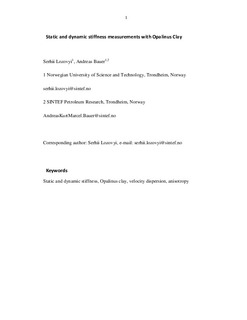Static and dynamic stiffness measurements with Opalinus Clay
Journal article, Peer reviewed
Accepted version
Permanent lenke
http://hdl.handle.net/11250/2583178Utgivelsesdato
2018Metadata
Vis full innførselSamlinger
Originalversjon
10.1111/1365-2478.12720Sammendrag
In this work, an experimental study was carried out with the aim of reconciling static and dynamic stiffness of Opalinus Clay. The static and dynamic stiffness of core plugs from a shaly and a sandy facies of Opalinus Clay were characterized at two different stress states. The measurements included undrained quasi-static loading-unloading cycles from which the static stiffness was derived, dynamic stiffness measurement at seismic frequencies (0.5 – 150 Hz), and ultrasonic velocity measurements (500 kHz) probing the dynamic stiffness at ultrasonic frequencies. The experiments were carried out in SINTEF's low-frequency cell. The obtained results demonstrate that the difference between static and dynamic stiffness is due to both dispersion and non-elastic effects: Both the sandy and the shaly facies of Opalinus Clay exhibit large dispersion, i.e. a large frequency dependence of dynamic stiffness and acoustic velocities. Especially the dynamic Young's moduli exhibit very high dispersion; between seismic and ultrasonic frequencies they may change by more than a factor 2. P-wave velocities perpendicular to bedding are by more than 200 m/s higher at ultrasonic frequencies than at seismic frequencies. The static undrained stiffness of both the sandy and the shaly facies is strongly influenced by non-elastic effects, resulting in significant softening during both loading and unloading with increasing stress amplitude. The zero-stress extrapolated static undrained stiffness, however, reflects the purely elastic response and agrees well with the dynamic stiffness at seismic frequency.
